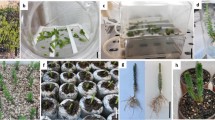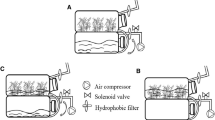Abstract
Crescentia cujete L. is a widely distributed medicinal tree with a diverse range of phytochemicals used as medicinal compounds. Seedlings of wild-harvested C. cujete were established in vitro and used as the starting material for the establishment of axenic cultures. Shoots were proliferated from nodal segments and were maintained over a period of more than 2 years by sequential subculture on a medium containing 1.0 µmol l−1 kinetin. De novo regeneration was induced on petiole sections cultured onto a medium containing thidiazuron in combination with 2,4-dichlorophenoxyacetic acid. Axenic cultures were also used to test the efficiency of three different cultivation systems for production of biomass of C. cujete. Growth of plantlets in a temporary immersion bioreactor resulted in significant increases in biomass, leaf number, shoot height and transplant efficiency. Plantlets grown in the bioreactors were acclimatized under greenhouse conditions. Together, these experiments have established optimized parameters for propagation and growth of C. cujete plantlets in a sterile controlled environment for biochemical characterization and production of high-quality medicinal products.
Similar content being viewed by others
References
Etienne H & Berthouly M (2002) Temporary immersion systems in plant micropropagation. Plant Cell Tiss. Org. Cult. 69: 215-231
Gamborg OL, Miller RA & Ojima K (1968) Nutrient requirement of suspension cultures of soybean root cells. Exp. Cell Res. 50: 150-158
Heltzel CE, Gunatilaka AAL, Glass TE & Kingston DGI (1993) Bioactive furanonaphthoquinones: bioactive compounds with a novel fused ring system from Crescentia cujete. Tetrahedron 49: 6757-6762
Hutchinson MJ, Murch SJ & Saxena PK (1996) Morphoregulatory role of thidiazuron: evidence of the involvement of endogenous auxin in thidiazuron-induced somatic embryogenesis of geranium (Pelargonium × hortorum Bailey). J. Plant Physiol. 149: 573-579
Kaneko T, Ohtani K, Kasai R, Yomasaki K & Duc NM (1997) Iridoids and iridoid glucosides from fruits of Crescentia cujete. Phytochemistry 46: 907-910
Kaneko T, Ohtani K, Kasai R, Yamasaki K & Duc NM (1998) n-Alkyl glycosides and p-hydroxybenzoyloxy glucose from fruits of Crescentia cujete. Phytochemistry 47: 259-263
Liu CZ, Murch SJ, EL-Demerdash M & Saxena PK (2003) Regeneration of the Egyptian medicinal plant Artemisia judaica L. Plant Cell Rep. 21: 525-530
Murashige T & Skoog F (1962) A revised medium for rapid growth and bioassays with tobacco tissue cultures. Physiol. Plant. 15: 473-497
Murch SJ & Saxena PK (2001) Molecular fate of thidiazuron and its effects on auxin transport in hypocotyls tissues of Pelargonium × hortorum Bailey. Plant Growth Reg. 35: 269-275
Murch SJ, KrishnaRaj S & Saxena PK (1997) Thidiazuron induced morphogenesis of regal geranium (Pelargonium domesticum): a potential stress response. Physiol. Plant. 101: 183-191
Murch SJ, Victor JMR, KrishnaRaj S & Saxena PK (1999) The role of proline in thidiazuron-induced somatic embryogenesis of peanut. In Vitro Cell Biol. Plant 35: 102-105
Murch SJ, Choffe KL & Saxena PK (2001) The unique challenges of plant-based medicines. In: Saxena PK (ed) Development of Plant-Based Medicines: Conservation, Efficacy and Safety (pp. 107-118). Kluwer Academic Publishers, Dordrecht
Murthy BNS, Murch SJ & Saxena PK (1995) Thidiazuron induced somatic embryogenesis in intact seedlings of peanut (Arachis hypogaea L.): endogenous growth regulator levels and significance of cotyledons. Physiol. Plant. 94: 268-276
Murthy BNS, Murch SJ & Saxena PK (1998) Thidiazuron: a potent regulator of in vitro plant morphogenesis. In Vitro Cell Biol. Plant 34: 267-275
Otero R, Nunez V, Barona J, Fonnegra R, Jimenez SL, Osorio RG, Saldarriaga M & Diaz A (2000) Snakebites and ethnobotany in the northwest region of Colombia: Part III: neutralization of the haemorrhagic effect of Bothrops atrox venom. J. Ethnopharmacol. 73: 233-241
Saxena PK (2001) Development of Plant-based Medicines: Conservation, Efficacy and Safety. (Edn) Kluwer Academic Publishers, Dordrecht, The Netherlands
Zobayed SMA, Murch SJ, Rupasinghe HPV & Saxena PK (in press) In vitro production and chemical characterization of St. John's wort (Hypericum perforatum L. cv.‘New Stem’). Plant Sci.
Author information
Authors and Affiliations
Rights and permissions
About this article
Cite this article
Murch, S.J., Liu, C., Romero, R.M. et al. In vitro Culture and Temporary Immersion Bioreactor Production of Crescentia cujete . Plant Cell, Tissue and Organ Culture 78, 63–68 (2004). https://doi.org/10.1023/B:TICU.0000020397.01895.3e
Issue Date:
DOI: https://doi.org/10.1023/B:TICU.0000020397.01895.3e




